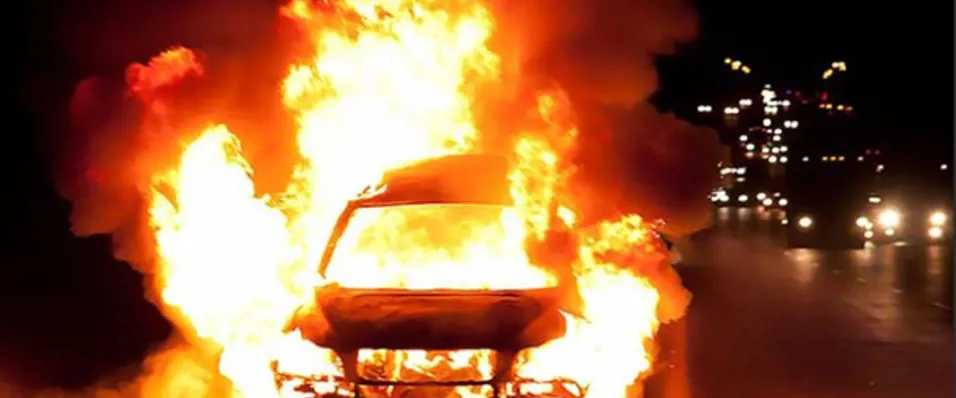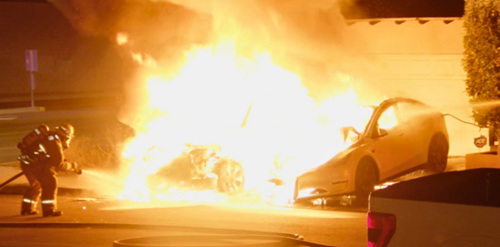
Electric vehicle charging point fire safety considerations
Some would argue that the installation of an EVCP is no different to installing any other type of socket-outlet. This article points out why this is not the case. Given the characteristics of the connected load, further consideration is required when determining a suitable location to charge an EV with respect to fire safety. It is quite easy for the installer to think that their job ends at the socket-outlet, but it would be remiss not to consider the implications for fire safety with respect to the EV.
What are the requirements in BS 7671:2018+A2:2022 regarding the location of EVCPs?
Section 722 of BS 7671:2018+A2:2022 provides requirements for EVs. The specific requirements in Section 722 of BS 7671:2018+A2:2022 relate to external influences such as the presence of water, solid foreign bodies and impact, but there are no specific requirements relating to fire safety.
It is important to remember that the Part 7 Sections of BS 7671 are used to modify or supplement the general requirements. For the installation of an EVCP, the general requirements of BS 7671 apply.
Chapter 42 of BS 7671:2018+A2:2022 provides requirements for protection against thermal effects. This includes locations with risks of fire due to the nature of processed or stored materials, combustible construction materials and fire propagating structures.
Appendix 5 of BS 7671:2018+A2:2022 provides a concise list of external influences. The classification CB 2 is for fire propagation.
However, EVs require further consideration when it comes to fire safety.
What are the fire safety risks for an EVCP?
The main concern regarding the risk of fire is the EV, not the EVCP. Thankfully, it doesn’t happen very often but when an electric vehicle catches fire, the consequences can be catastrophic.
EVs are powered by lithium-ion batteries which have a large storage capacity, thus large amounts of stored energy. The main danger with lithium-ion batteries is, when they become faulty, damaged or exposed to extreme heat, thermal runaway can occur causing an exothermic reaction. This creates dense smoke and toxic vapours and gases, such as carbon monoxide and hydrogen cyanide which are deadly if breathed in.
EV fires present new challenges for fire and rescue services as extinguishing an EV fire requires large amounts of water and the fire can reignite hours or sometimes days later. Experts are divided on the best way to fight EV fires and new, innovative ideas are being developed.
How common are electric vehicle fires?
As EVs are a new technology, when one catches fire it is likely to make headline news. However, it is important to keep things in perspective. According to the Bedfordshire Fire & Rescue Service website, in 2019 the London Fire Brigade (LFB) dealt with 54 EV fires compared with 1898 petrol and diesel fires.
Vehicle registrations from the Department for Transport (DfT) show that of the 4.63 million cars in London, 50,000 of these are plug-in cars. When compared with the data from LFB, this suggests an incident rate of 0.04 % for petrol and diesel car fires and 0.1 % for electric vehicles.
What are the fire safety risks for an EV?
For ease of installation and cable routes, it can be tempting to install an EVCP on an exterior wall of a building, but it may not be the best place with respect to fire safety. One important factor to consider is fire spread to an adjacent building. Given the ferocity of a lithium-ion battery fire, it wouldn’t take long for an EV fire to spread to combustible materials or melt exterior PVC doors and windows in proximity. Another consideration is if an EV on charge was to catch fire, would it impede access and egress from the building?
The fire safety risk increases when EVs are charged in enclosed spaces, such as underground car parks. Where there are multiple EVCPs, the fire could spread from one EV to another in an adjacent parking space. Early detection by a fire alarm system and sprinklers provide the best form of active fire protection for enclosed car parks to contain the fire, however, fire and rescue services are still required to extinguish the fire.
Other considerations include proximity to flammable materials, such as fuel storage tanks and low overhanging roofs where fire could spread to the building roof structure.
Where can I find information regarding fire safety considerations for the location of an EVCP?
Before starting any work, it is important to check that the client has spoken with their insurance company to establish if they have any requirements for the location of EVCPs. Regardless of whose responsibility it is, you won’t be thanked if the client is subsequently advised by their insurance company that they are not covered as the EVCPs are installed on the exterior wall of the building.
The insurance company, Zurich, have produced a useful guidance document to highlight the fire safety risks for EVs. The guidance states that EV charging should take place at least 10 m from combustible walls or at least 7.5 m from unprotected/extensive glazing in non-combustible walls.
A guidance document produced by RISCAuthority RC59 provides recommendations for fire safety when charging EVs.
The IET Code of Practice for Electric Vehicle Charging Equipment Installation, 5th Edition has been published and provides guidance on fire safety considerations for the location of an EVCP.
What is the law for domestic premises?
The requirements of the Building Regulations apply to domestic and commercial installations.
Approved Document S of the Building Regulations provides requirements for infrastructure for the charging of electric vehicles. This Approved Document does not provide guidance on electrical or fire safety but does refer to Approved Document P and Approved Document B respectively.
What is the law for commercial and industrial premises?
The Health & Safety at Work Act 1974 outlines the general duties of employers, those who are self-employed, and employees. The specific details are provided in The Management of Health and Safety at Work Regulations 1999.
Regulation 3 – Risk assessment requires: “every employer to make a suitable and sufficient risk assessment of:
- the risks to the health and safety of his employees to which they are exposed whilst they are at work and;
- the risks to the health and safety of persons not in his employment arising out of or in connection with the conduct by him or his undertaking.”
The Regulatory Reform (Fire Safety) Order came into force in 2005 and sets out the requirements for fire safety in almost all buildings other than individual private homes. In particular, Regulation 9 – Risk Assessment requires the responsible person to make a suitable and sufficient assessment of risks to which relevant persons are exposed for the purpose of identifying the general fire precautions. The Regulatory Reform (Fire Safety) Order 2005 also provides requirements for firefighting and fire detection.
The Construction (Design and Management) Regulations 2015 also apply to all construction work. The designer has a duty to eliminate foreseeable health and safety risks to anyone affected by the project and take steps to reduce or control any risks that cannot be eliminated. When a contractor works for a domestic client, it is no different to working for a commercial client, however, the client’s responsibilities are taken on by the contractor.
What is the guidance for installing EVCPs at domestic installations?
Whilst some of the legislation mentioned above does not apply directly to the client in domestic premises, it would be sensible to take a similar approach to that given in the available guidance documents with respect to fire safety. For domestic installations, this can be challenging, especially for properties with a small curtilage. It is important any risks are discussed with the client to allow them to make an informed decision for a suitable location.
It may be that professional fire engineering advice is required and additional fire protection measures may be required to manage certain risks. Where there is uncertainty and fire engineering advice is required, it is important to consult a fire engineer. The Institution of Fire Engineers website features an online directory of qualified fire engineers with different areas of expertise.
Further reading
The IET Code of Practice for Electric Vehicle Charging Equipment Installation, 5th Edition
RISCAuthority RC59 Recommendations for fire safety when charging electric vehicles
Zurich Risk Insight: Electric Vehicle Charging
The Health & Safety at Work Act 1974
The Management of Health and Safety at Work Regulations 1999
The Construction (Design and Management) Regulations 2015
The Regulatory Reform (Fire Safety) Order 2005
Approved Document B (Fire safety)
Approved Document P (Electrical safety)
Approved Document S (Infrastructure for the charging of electric vehicles)
Acknowledgements
I would like to record my thanks and support to the following people for their continued support and input to this article:
- Craig O’Neill
- Gary Gundry
- John Peckham
- Leon Markwell
- Mark Coles
- Steven Devine

